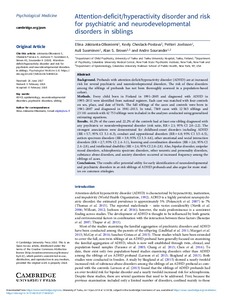Attention-deficit/hyperactivity disorder and risk for psychiatric and neurodevelopmental disorders in siblings
Auli Suominen; Elina Jokiranta-Olkoniemi; Keely Cheslack-Postava; Andre Sourander; Petteri Joelsson; Alan S. Brown
https://urn.fi/URN:NBN:fi-fe2021042719162
Tiivistelmä
Background: Probands with attention-deficit/hyperactivity disorder (ADHD) are at increased risk for several psychiatric and neurodevelopmental disorders. The risk of these disorders among the siblings of probands has not been thoroughly assessed in a population-based cohort.
Methods: Every child born in Finland in 1991–2005 and diagnosed with ADHD in 1995–2011 were identified from national registers. Each case was matched with four controls on sex, place, and date of birth. The full siblings of the cases and controls were born in 1981–2007 and diagnosed in 1981–2013. In total, 7369 cases with 12 565 siblings and 23 181 controls with 42 753 siblings were included in the analyses conducted using generalized estimating equations.
Results: 44.2% of the cases and 22.2% of the controls had at least one sibling diagnosed with any psychiatric or neurodevelopmental disorder (risk ratio, RR = 2.1; 95% CI 2.0–2.2). The strongest associations were demonstrated for childhood-onset disorders including ADHD (RR = 5.7; 95% CI 5.1–6.3), conduct and oppositional disorders (RR = 4.0; 95% CI 3.5–4.5), autism spectrum disorders (RR = 3.9; 95% CI 3.3–4.6), other emotional and social interaction disorders (RR = 2.7; 95% CI 2.4–3.1), learning and coordination disorders (RR = 2.6; 95% CI 2.4–2.8), and intellectual disability (RR = 2.4; 95% CI 2.0–2.8). Also, bipolar disorder, unipolar mood disorders, schizophrenia spectrum disorders, other neurotic and personality disorders, substance abuse disorders, and anxiety disorders occurred at increased frequency among the siblings of cases.
Conclusions: The results offer potential utility for early identification of neurodevelopmental and psychiatric disorders in at-risk siblings of ADHD probands and also argue for more studies on common etiologies.
Kokoelmat
- Rinnakkaistallenteet [19204]
